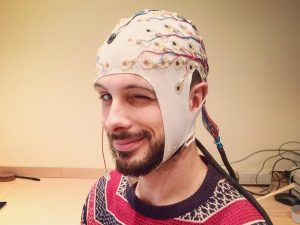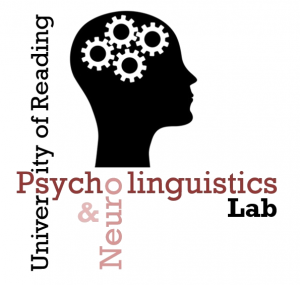 Our research in bi-/multilingualism investigates the similarities and differences between monolingual and bilingual language processing, especially Sentence Processing, and the factors that influence successful additional non-native language learning. Our work in this regards combines behavioural techniques including reaction time experiments and eye-tracking, along with neuroscientific methods such as EEG/ERG and MRI.
Our research in bi-/multilingualism investigates the similarities and differences between monolingual and bilingual language processing, especially Sentence Processing, and the factors that influence successful additional non-native language learning. Our work in this regards combines behavioural techniques including reaction time experiments and eye-tracking, along with neuroscientific methods such as EEG/ERG and MRI.
In close links to our work in the Cognitive Neuroscience of Language, we also examine the interaction between language and cognition, and how multilingualism and additional language learning affects brain structure and function. More broadly, our work in bi-/multilingualism is also closely linked to the university’s Centre for Literacy and Multilingualism, a multidisciplinary research institute into literacy development and multilingualism.
Representative Publications
Fujita, H. & Cunnings, I. (2024). Subject-verb dependency formation and semantic interference in native and non-native language comprehension. Applied Psycholinguistics, 45, 81-109.
Wesierska, M. Serratrice, L., Cieplinska, V. & Messenger, K. (2024). Investigating crosslinguistic representations in Polish–English bilingual children: Evidence from structural priming. Bilingualism: Language and Cognition. First View.
Cunnings, I. & Fujita, H. (2023). Similarity-based interference and relative clauses in second language processing. Second Language Research, 39, 539-563.
Valentini, A. and Serratrice, L. (2023). Longitudinal predictors of listening comprehension in bilingual primary school-aged children. Language Learning, 73, 5-46.
Alrwaita, N., Houston-Price, C. and Pliatsikas, C. (2022). The effects of using two varieties of one language on cognition: evidence from bidialectalism and diglossia. Linguistic Approaches to Bilingualism. OnlineFirst.
Cheng, Y. Cunnings, I., Miller, D. and Rothman, J. (2022). Double-number marking matters for both L1 and L2 processing of nonlocal agreement similarly: an ERP investigation. Studies in Second Language Acquisition, 44, 1309-1329.
Cheng, Y., Rothman, J. & Cunnings, I. (2022). Determiner-number specification and non-local agreement computation in L1 and L2 processing. Journal of Psycholinguistic Research, 51, 847-863.
Cunnings, I. (2022). ‘Working memory and L2 sentence processing’ in Schwieter, J. & Wen, Z. (eds.), The Cambridge Handbook of Working Memory and Language, Cambridge, Cambridge University Press, 593-612.
Fujita, H. & Cunnings, I. (2022). Interference and filler-gap dependency formation in native and non-native language comprehension. Journal of Experimental Psychology: Learning, Memory and Cognition, 48, 702-716.
Kašćelan, D., Prévost, P., Serratrice, L., Tuller, L., Unsworth, S. and De Cat, C. (2022). A review of questionnaires quantifying bilingual experience in children: do they document the same constructs? Bilingualism: Language and Cognition, 25, 29-41.
Cheng, Y., Rothman, J. and Cunnings, I. (2021). Parsing preferences and individual differences in nonnative sentence processing: Evidence from eye movements. Applied Psycholinguistics, 42, 129-151.
Cunnings, I. & Fujita, A. (2021). Quantifying individual differences in native and non-native sentence processing. Applied Psycholinguistics, 42, 579-599.
DeLuca, V., Rothman, J., Bialystok, E. and Pliatsikas, C. (2020). Duration and extent of bilingual experience modulate neurocognitive outcomes. NeuroImage, 204, 116222
Fujita, H. & Cunnings, I. (2021). Reanalysis processes in non-native sentence comprehension. Bilingualism: Language and Cognition, 24, 628-641.
Fujita, H. and Cunnings, I. (2021). Reanalysis and lingering misinterpretation of linguistic dependencies in native and non-native sentence comprehension. Journal of Memory and Language, 115, 104154.
Fujita, H. and Cunnings, I. (2021). Lingering misinterpretation in native and nonnative sentence processing: Evidence from structural priming. Applied Psycholinguistics, 42, 475-504.
Pliatsikas, C. (2020). Understanding structural plasticity in the bilingual brain: The Dynamic Restructuring Model. Bilingualism: Language and Cognition, 23, 459-471.
Serratrice, L. and De Cat, C. (2020). Individual differences in the production of referential expressions: The effect of language proficiency, language exposure and executive function in bilingual and monolingual children. Bilingualism: Language and Cognition, 23, 371-386.
DeLuca, V., Rothman, J., Bialystok, E. and Pliatsikas, C. (2019). Redefining bilingualism as a spectrum of experiences that differentially affects brain structure and function. Proceedings of the National Academy of Sciences of the United States of America, 116, 7565-7574.
De Cat, C., Gusnanto, A. and Serratrice, L. (2018). Identifying a threshold for the executive function advantage in bilingual children. Studies in Second Language Acquisition, 40, 119-151.
DeLuca, V., Rothman, J. and Pliatsikas, C. (2019) Linguistic immersion and structural effects on the bilingual brain: a longitudinal study. Bilingualism: Language and Cognition, 22, 1160-1175.
Denhovska, N., Serratrice, L. and Payne, J. (2018). Frequency and working memory effects in incidental learning of a complex agreement pattern. Lingua, 207, 49-70.
Herve, C. and Serratrice, L. (2018). The development of determiners in the context of French-English bilingualism: a study of cross-linguistic influence. Journal of Child Language, 45, 767-787.
Roberts, L., González Alonso, J., Pliatsikas, C. and Rothman, J. (2018). Evidence from neurolinguistic methodologies: can it actually inform linguistic/ language acquisition theories and translate to evidence-based applications? Second Language Research, 34, 125-143.
Cunnings, I. (2017). Parsing and working memory in bilingual sentence processing. Bilingualism: Language and Cognition, 20, 659-678.
Cunnings, I., Fotiadou, G. and Tsimpli, I. (2017). Anaphora resolution and reanalysis during L2 sentence processing: evidence from the visual world paradigm. Studies in Second Language Acquisition, 39, 621-652.
Pliatsikas, C., DeLuca, V., Moschopoulou, E. and Saddy, J. D. (2017). Immersive bilingualism reshapes the core of the brain. Brain Structure and Function, 222, 1785-1795.
Pliatsikas, C., Johnstone, T. and Marinis, T. (2017). An fMRI study on the processing of long-distance wh-movement in a second language. Glossa: A Journal of General Linguistics, 2, 101.
Denhovska, N., Serratrice, L. and Payne, J. (2016). Acquisition of second language grammar under incidental learning conditions: the role of frequency and working memory. Language Learning, 66, 159-190.
Pliatsikas, C. and Luk, G. (2016). Executive control in bilinguals: a concise review on fMRI studies. Bilingualism: Language and Cognition, 19, 699-705.
Serratrice, L. (2016). Cross-linguistic influence, cross-linguistic priming and the nature of shared syntactic structures. Linguistic Approaches to Bilingualism, 6, 822-827.
Pliatsikas, C., Moschopoulou, E. and Saddy, J. D. (2015). The effects of bilingualism on the white matter structure of the brain. Proceedings of the National Academy of Sciences of the United States of America, 112, 1334-1337.

